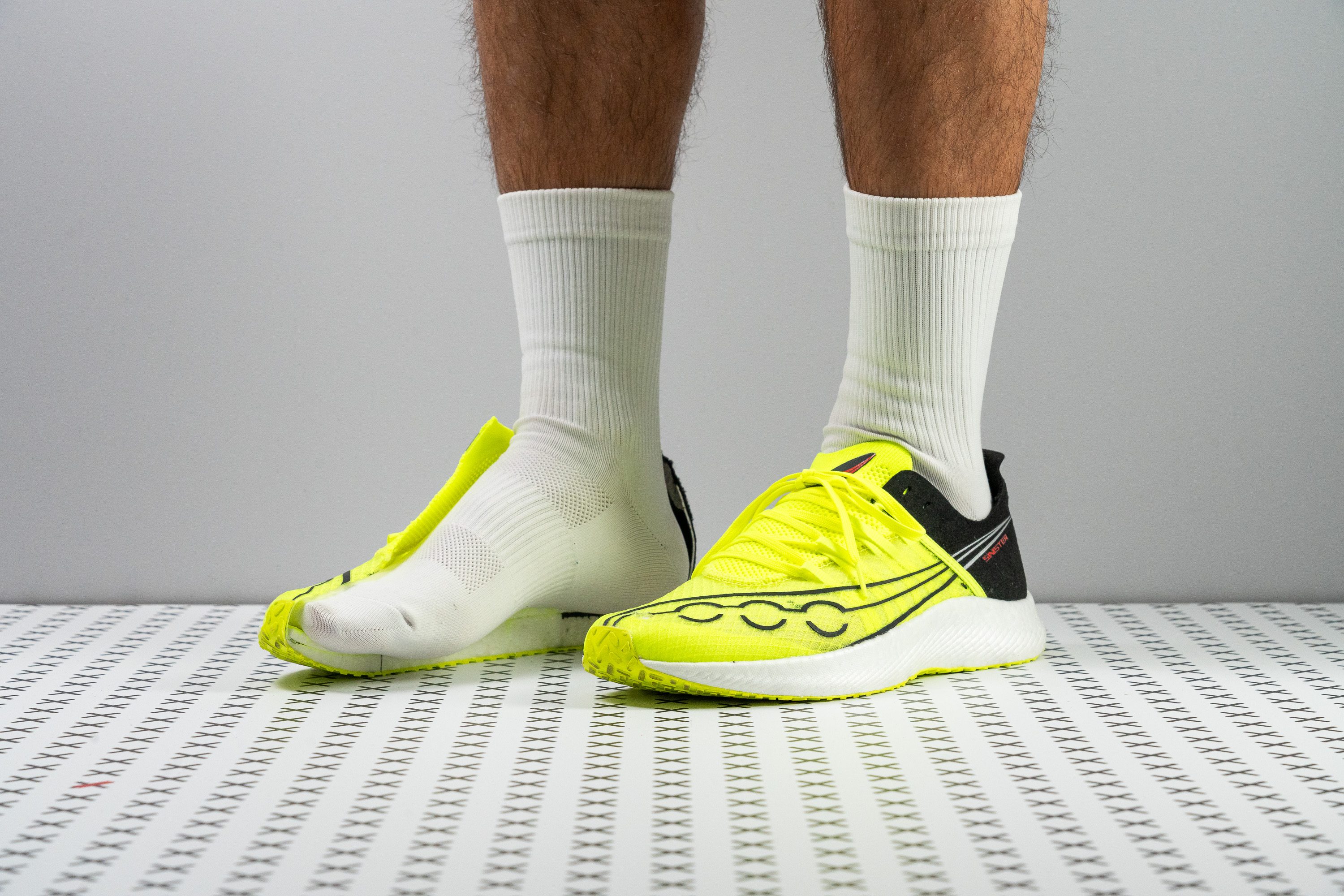Our verdict
Pros
- Insanely lightweight
- Outstanding energy return from PWRRUN PB
- Delivers an impressively quick and enjoyable ride
- Incredibly flexible for a true natural feel
- Perfect for enthusiasts of racing flats
- Excellent for dynamic track workouts
- Remarkable lockdown for narrow feet
- Optimal for short to moderate-distance races and tempo runs
Cons
- Falls short in durability
- Insufficient cushioning for longer distances
- Would improve a lot with only a tiny bit more foam
Audience verdict
Comparison
The most similar running shoes compared
+ + Add a shoe | |||||
|---|---|---|---|---|---|
| Audience score | 87 Great! | 89 Great! | 87 Great! | 89 Great! | |
| Price | £165 | £170 | £145 | £150 | |
| Pace | Tempo | CompetitionTempo | Tempo | Tempo | |
| Shock absorption | - | High | Moderate | Moderate | |
| Energy return | - | High | High | Low | |
| Traction | - | High | Moderate | Moderate | |
| Arch support | Neutral | Neutral | Neutral | Neutral | |
| Weight lab Weight brand | 5.3 oz / 149g 4.9 oz / 139g | 7.1 oz / 200g 6.9 oz / 196g | 6 oz / 171g 6 oz / 171g | 7 oz / 198g 7 oz / 199g | |
| Lightweight | ✓ | ✓ | ✓ | ✓ | |
| Drop lab Drop brand | 7.8 mm 6.0 mm | 7.8 mm 6.0 mm | 6.3 mm 6.0 mm | 9.0 mm 8.0 mm | |
| Strike pattern | Mid/forefoot | Mid/forefoot | Mid/forefoot | HeelMid/forefoot | |
| Size | Slightly small | Half size small | True to size | True to size | |
| Midsole softness | Balanced | Soft | Soft | Balanced | |
| Difference in midsole softness in cold | Small | Small | Small | Small | |
| Toebox durability | Bad | Bad | - | Good | |
| Heel padding durability | Good | Good | - | Decent | |
| Outsole durability | Decent | Bad | - | Good | |
| Breathability | Moderate | Breathable | Breathable | Moderate | |
| Width / fit | Narrow | Narrow | Narrow | Medium | |
| Toebox width | Medium | Medium | Medium | Medium | |
| Stiffness | Moderate | Moderate | Flexible | Flexible | |
| Torsional rigidity | Flexible | Stiff | Flexible | Flexible | |
| Heel counter stiffness | Flexible | Flexible | Flexible | Moderate | |
| Rocker | ✗ | ✗ | ✓ | ✗ | |
| Heel lab Heel brand | 25.2 mm 25.0 mm | 30.6 mm 33.0 mm | 31.7 mm 32.0 mm | 28.7 mm 28.0 mm | |
| Forefoot lab Forefoot brand | 17.4 mm 19.0 mm | 22.8 mm 27.0 mm | 25.4 mm 26.0 mm | 19.7 mm 20.0 mm | |
| Widths available | Normal | Normal | Normal | Normal | |
| Orthotic friendly | ✓ | ✓ | ✓ | ✓ | |
| Season | All seasons | SummerAll seasons | SummerAll seasons | All seasons | |
| Removable insole | ✓ | ✓ | ✓ | ✓ | |
| Ranking | #156 Top 42% | #90 Top 24% | #151 Top 41% | #97 Top 26% | |
| Popularity | #321 Bottom 14% | #284 Bottom 24% | #212 Bottom 43% | #176 Top 47% |
Who should buy
We believe the Sinister is perfect for:
- Runners who adore the low-profile feel of old-school racing flats yet crave the advantages of modern superfoam technology.
- Athletes who enjoy track workouts but need to avoid spikes to protect their calves and Achilles tendons.
- Enthusiasts of minimalist, lightweight running shoes seeking a high-performance racing option for their next 5K or 10K.
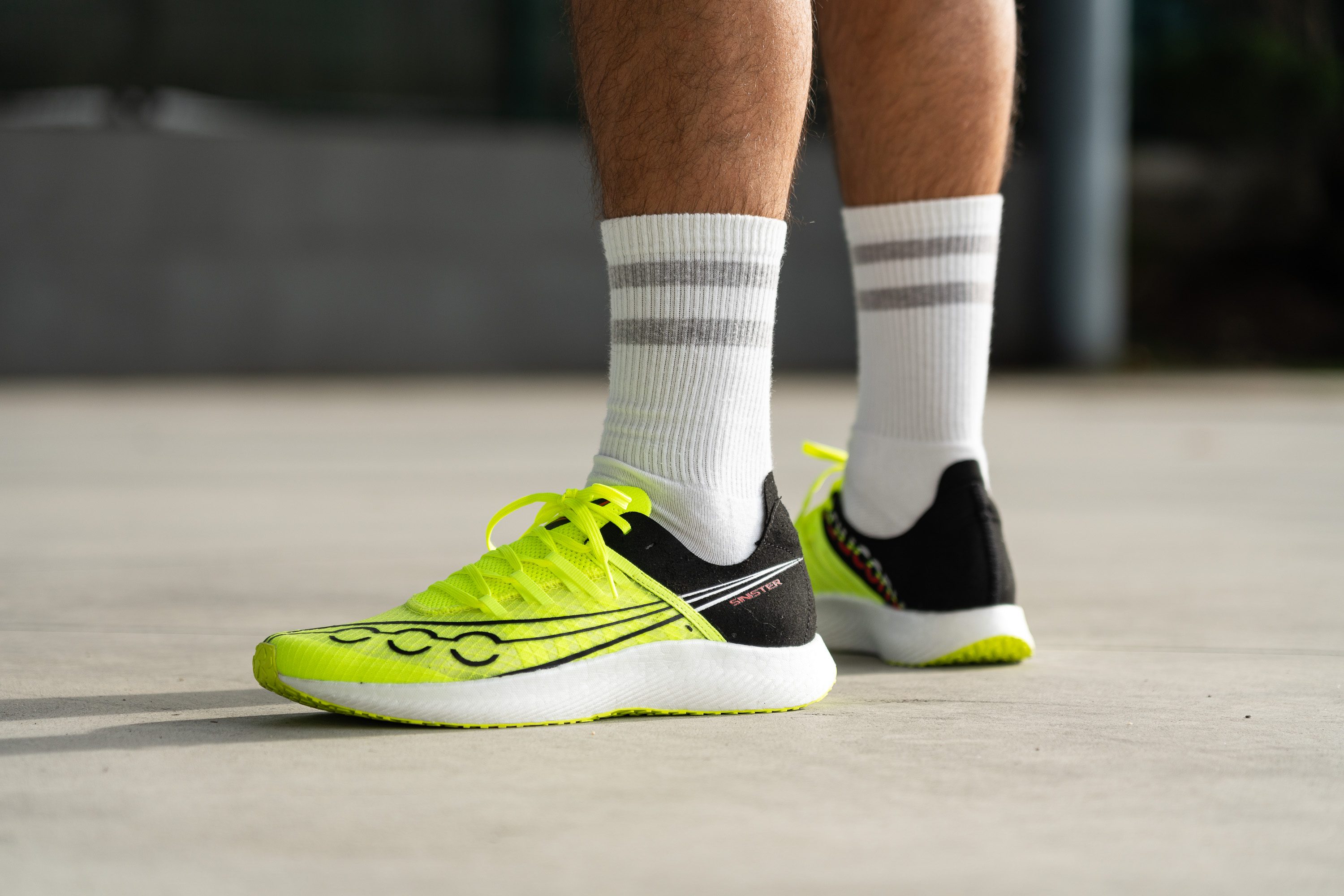
Who should NOT buy
The Sinister might not be ideal for distances beyond 10 miles, as it's crafted for shorter runs. In such cases, we recommend the Nike Streakfly. It shares benefits like a lightweight build and incredible flexibility, but it also provides a more cushioned ride suitable for even half marathons.
Similarly, if you're after best-in-class performance, the Sinister won't meet your needs. While its lightweight design does facilitate quick times, the combination of superfoam with a carbon plate is key for improving running economy. And this one lacks the plate.

A suitable alternative inside the brand is the Endorphin Pro 3, with the ASICS Metaspeed Edge+ or the Nike Vaporfly 3 also being worthy contenders.
Cushioning
Heel stack
To achieve such a low weight, Saucony reduced the stack height, which is only 25.2 mm in the heel.
However, this isn't bad news. It means the shoe caters to those who prefer low-stack shoes or those looking for a track workout shoe but want to avoid the muscular demands of training in spikes.
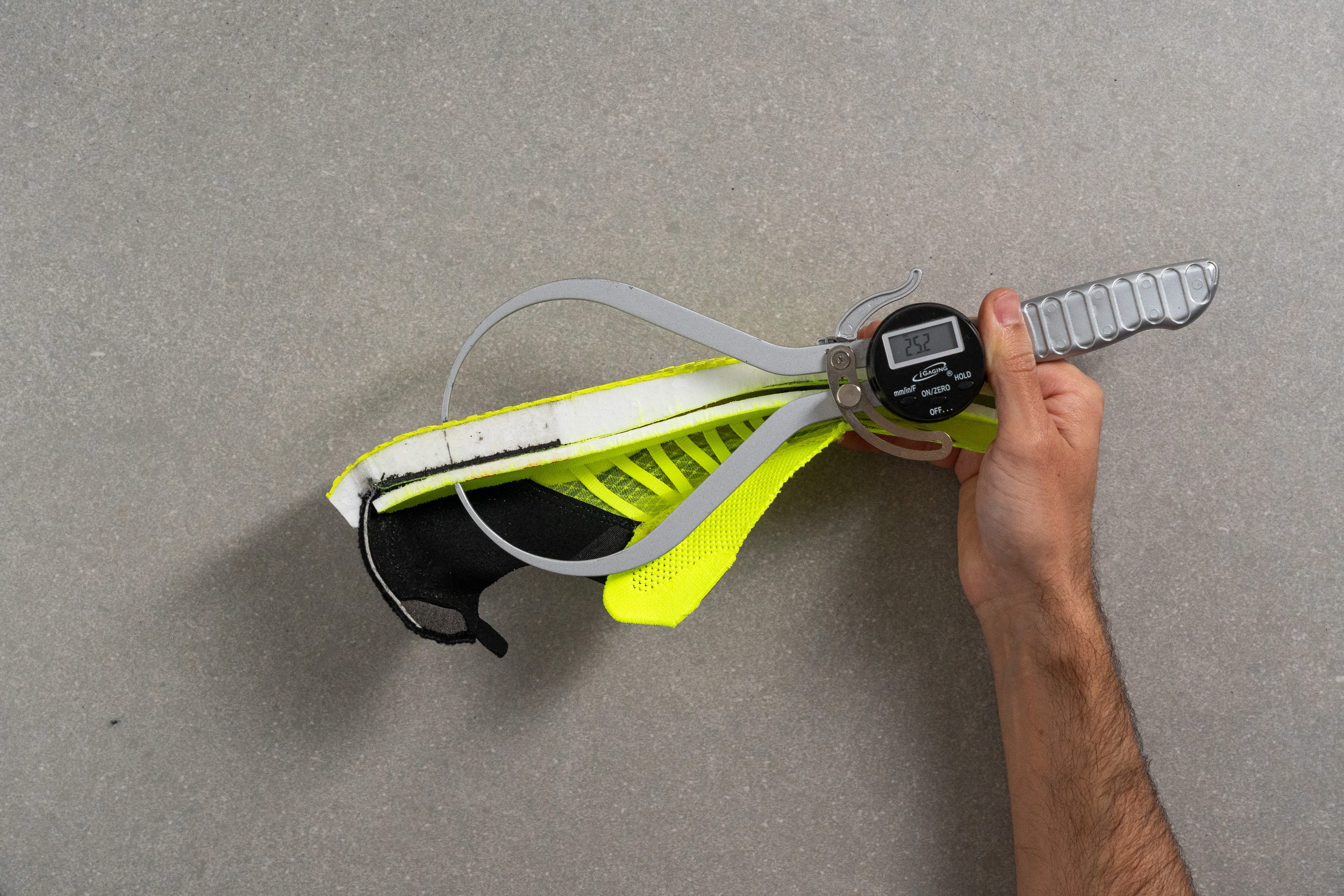
| Sinister | 25.2 mm |
| Average | 34.8 mm |
Forefoot stack
In the forefoot area, we found only 17.4 mm, which is lower than what's typically seen in road running shoes. However, since the outsole is so thin, most of it is foam.
This can feel great, especially for runners who are below 130 or 140 pounds. The sensation of ground feel with every stride is notably prominent.
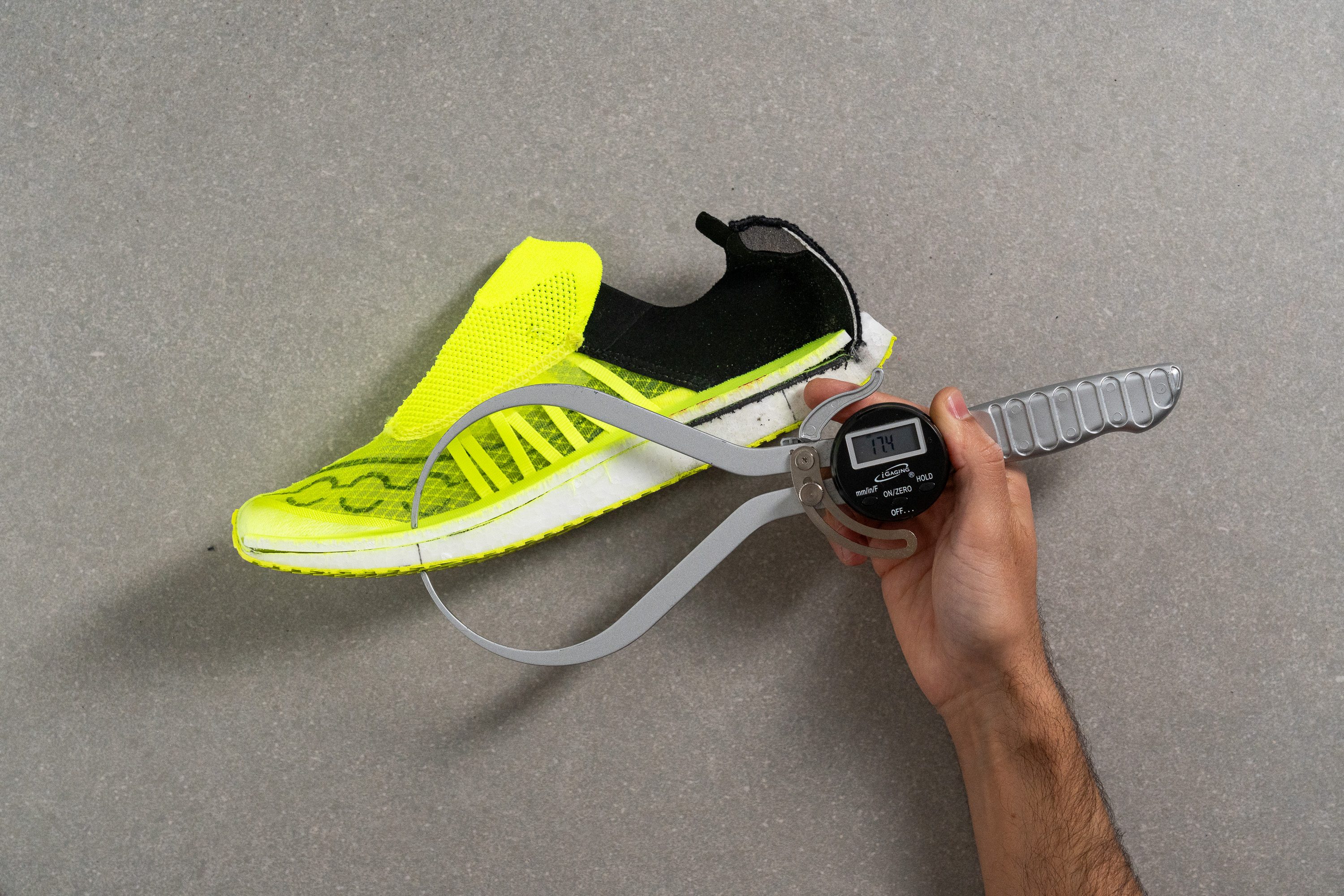
| Sinister | 17.4 mm |
| Average | 26.2 mm |
Drop
The difference between the previous two measurements results in a 7.8-mm drop, slightly different from the stated 6 mm.
However, this doesn't alter our previous statement—this shoe is a fantastic alternative for those who adore the feel of a track spike but prefer not to wear one because of injury concerns.
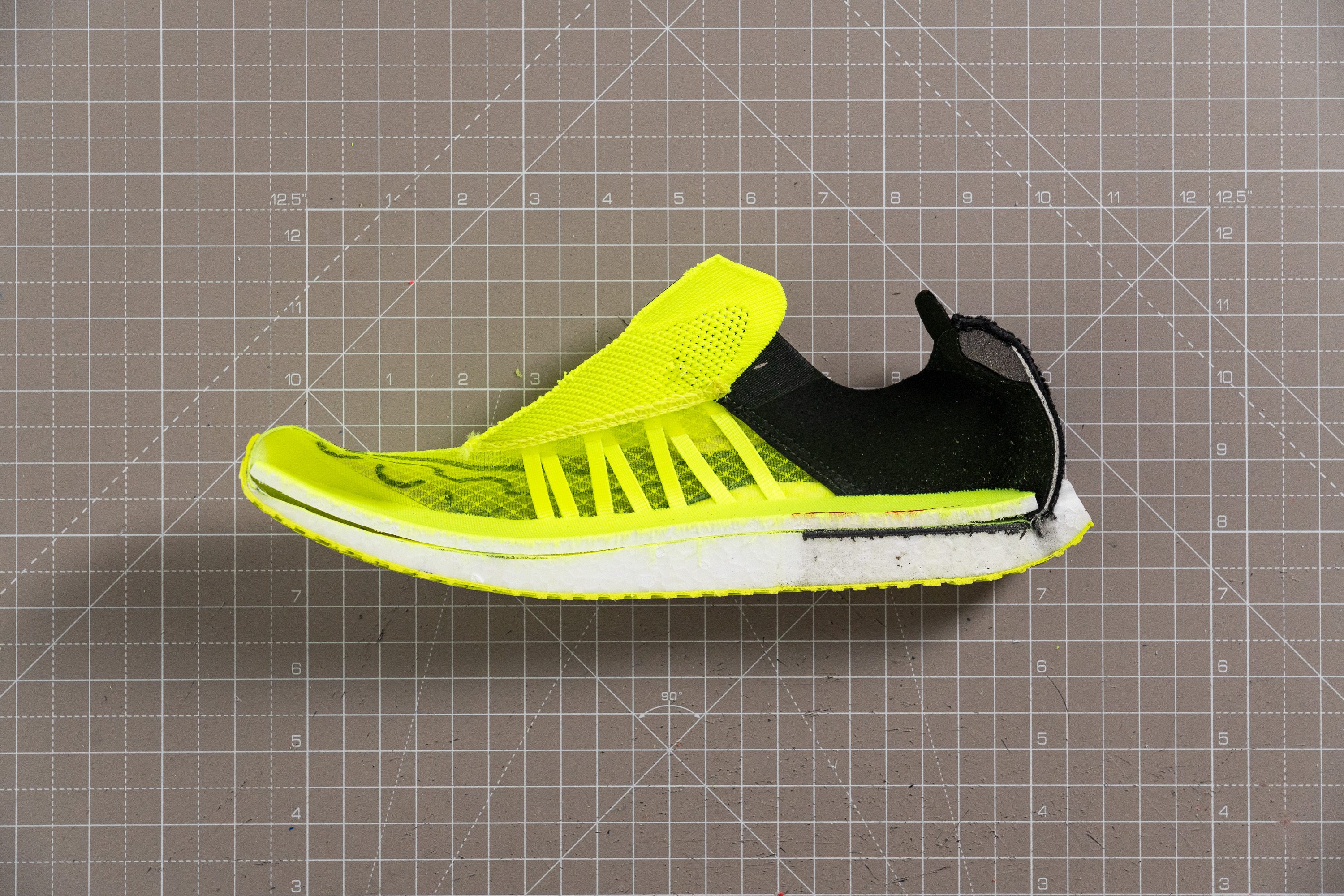
| Sinister | 7.8 mm |
| Average | 8.6 mm |
Midsole softness
In the midsole, we discovered a the Pebax-based PWRRUN PB foam, the same premium compound used in top-notch shoes like the Endorphin Speed 3, delivering best-in-class energy return.
This time, we measured it at 22.9 HA, which gives it a slightly firmer feel compared to other Saucony models. However, this makes perfect sense considering the Sinister's low profile.
Opting for a softer foam, especially without any kind of plate, would have led to bottoming out too hard with every stride.
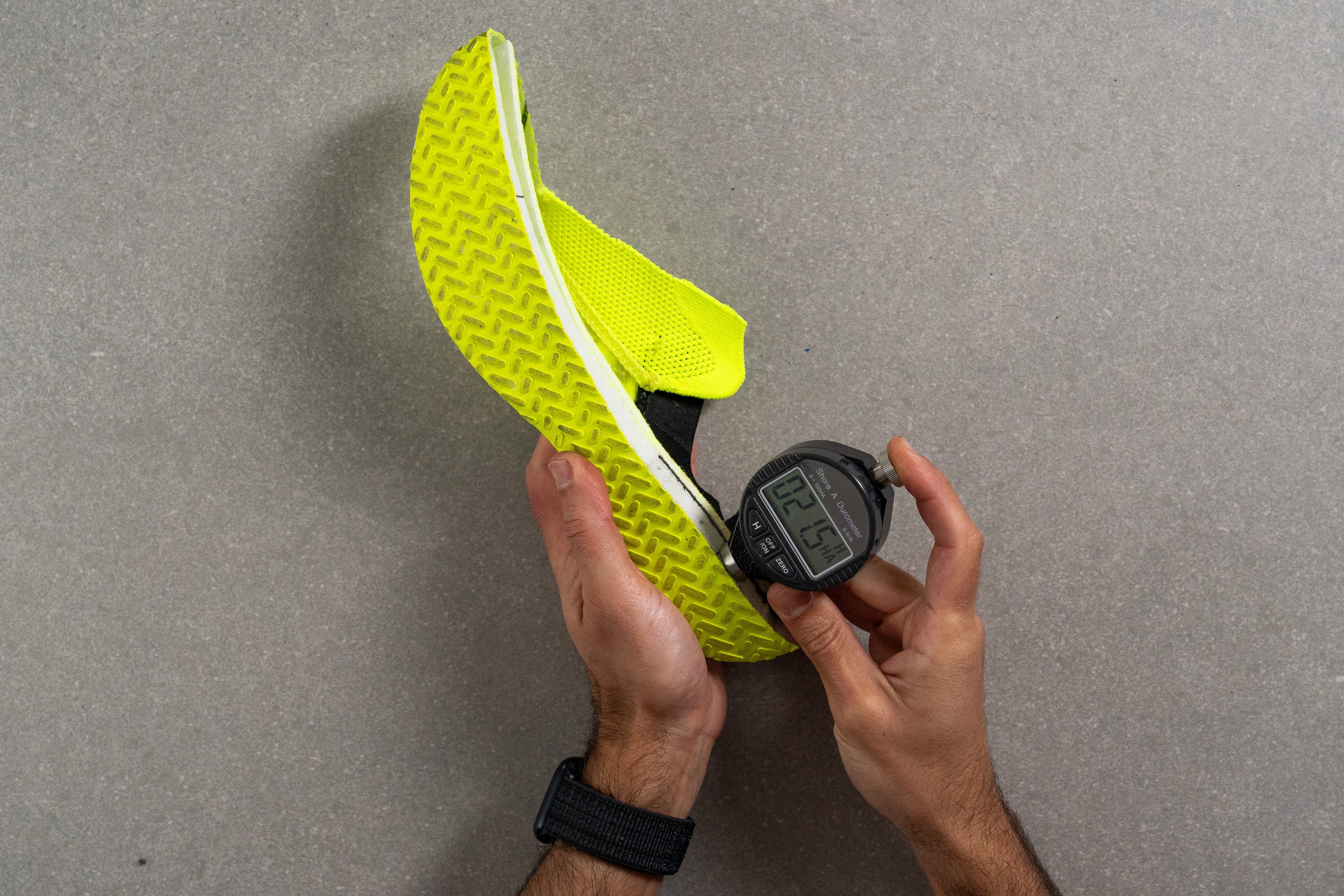
| Sinister | 22.9 HA |
| Average | 20.4 HA |
Size and fit
Size
Saucony Sinister fits slightly small (20 votes).
Width / Fit
Measuring 93.9 mm at its widest part, the fit is unquestionably snug, yet considering the shoe's overall dimensions, it's surprisingly roomy.

However, if you have wide feet, the Sinister might not be the best fit for you. On the flip side, those with narrow feet will find it exceptionally comfortable.

This test follows an older methodology, which is why you don't see recently tested shoes in the chart. Results from different methodologies can not be compared.
| Sinister | 93.9 mm |
| Average | 98.5 mm |
Toebox width
The big toe area, measuring a standard 78.1 mm, fits like your typical daily trainer, which is definitely a plus.
Saucony was smart with this design, as the shoe's shape allows for a less tapered toebox. While it might give the shoe a slightly unusual, almost clown-like appearance, this is a welcome feature for added comfort.
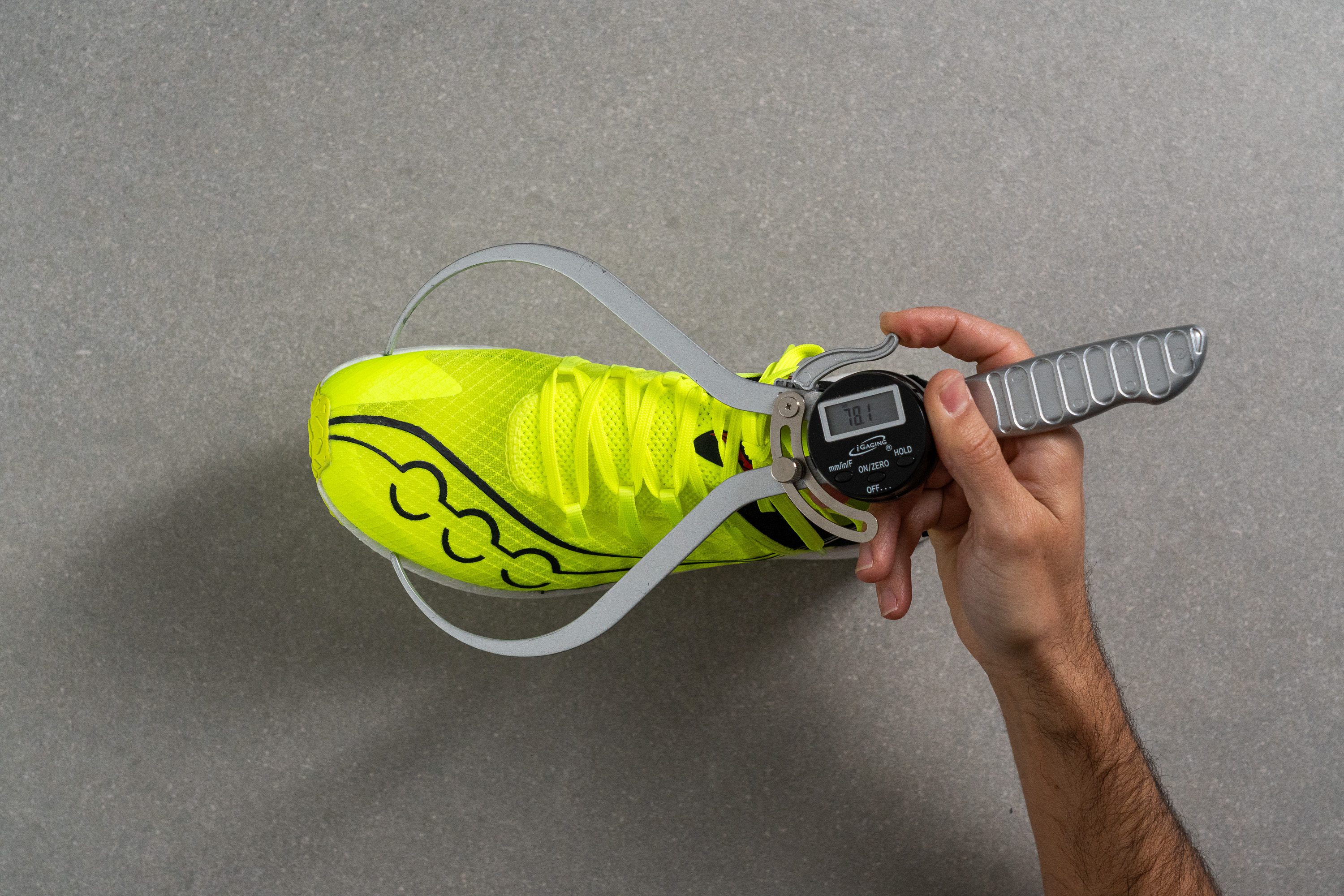
This test follows an older methodology, which is why you don't see recently tested shoes in the chart. Results from different methodologies can not be compared.
| Sinister | 78.1 mm |
| Average | 78.4 mm |
Flexibility / Stiffness
In line with the previous measurements, the stiffness of this shoe is incredibly low. In our 90-degree bend test, we were required to apply only 10.1N of force to bend it.
The absence of a plate contributes to this, but even most shoes without a plate have some degree of stiffness. This one simply doesn't—it almost feels like running in a Merrell Vapour Glove 6!
This test follows an older methodology, which is why you don't see recently tested shoes in the chart. Results from different methodologies can not be compared.
| Sinister | 10.1N |
| Average | 28.1N |
Stiffness in cold (%)
Under cold temperatures, the shoe performs remarkably consistently.
The mere 1.5% change we measured after a second 20-minute stint in the freezer is virtually imperceptible, even to us in the lab. This level of stability in varying conditions is truly impressive, and it all comes from the Pebax midsole.
| Sinister | 2% |
| Average | 33% |
Weight
Like every running shoe, it's all about balancing trade-offs. The Sinister may wear out a bit sooner, but it offers something few shoes on the market can—a featherlight weight of just 5.3 oz (149g).
This leads to an incredibly fun, agile, and natural ride, almost like running barefoot but with proper cushioning. In an era dominated by high-stacked, maximalist shoes, the Sinister is really unique.
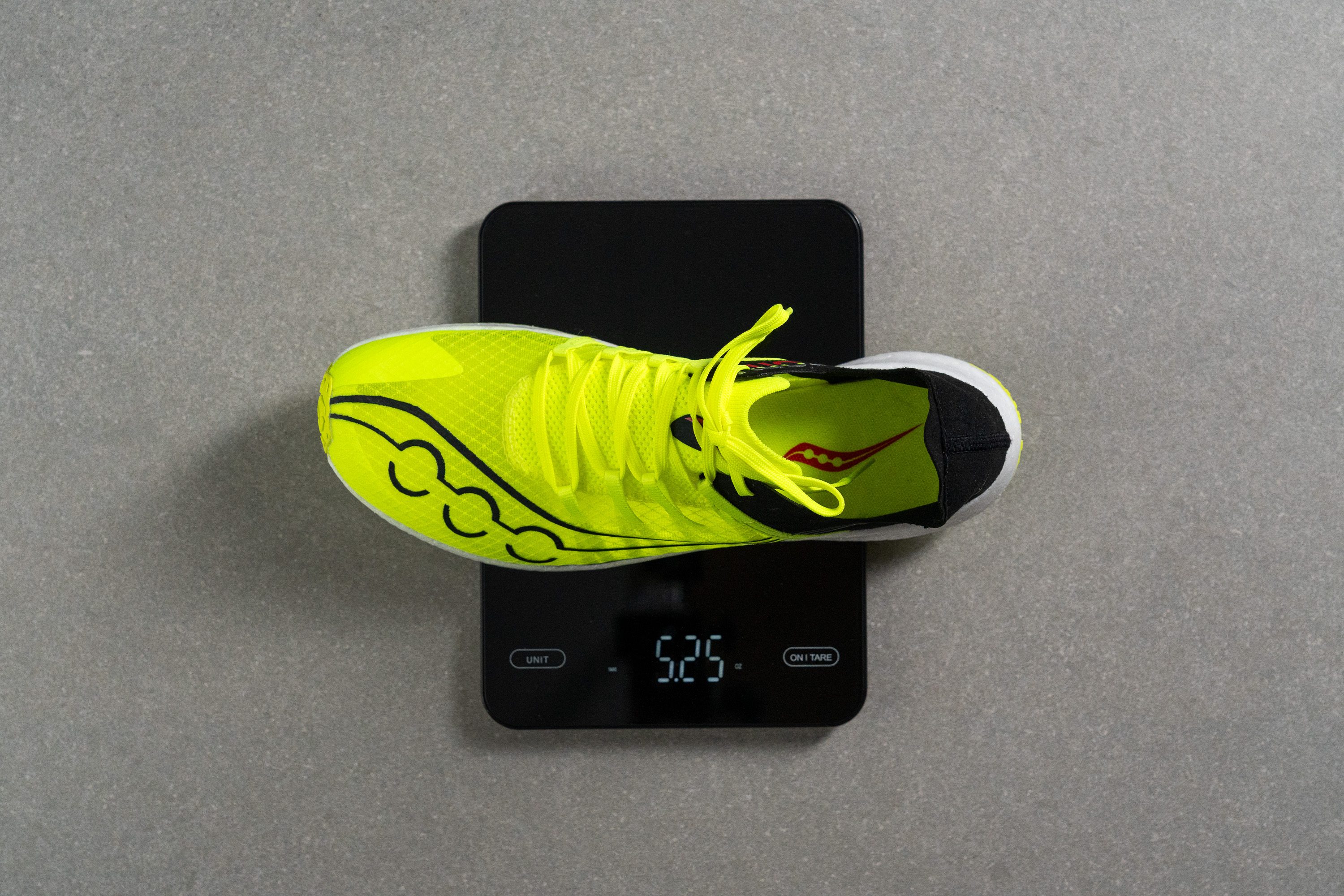
| Sinister | 5.3 oz (149g) |
| Average | 9.3 oz (264g) |
Breathability
We were genuinely excited to test the Sinister in our lab, as this shoe truly stands out in today's market. Its incredibly minimal upper led us to anticipate outstanding results in our first test—breathability.
However, we were a bit surprised when, after our smoke test, we rated the shoe 4 out of 5. This score indicates excellent airflow, though not the absolute best that we expected.
On the bright side, it's one of the few shoes that offers the same great ventilation on the medial side, not just in the toebox.
Shining a light through it, we noticed the paper-thin engineered mesh is pretty consistent across the medial side and the toebox. Beyond the mesh, there are only some reinforcements doubling as lace eyelets in the midfoot, and a TPU overlay on the toe cap.
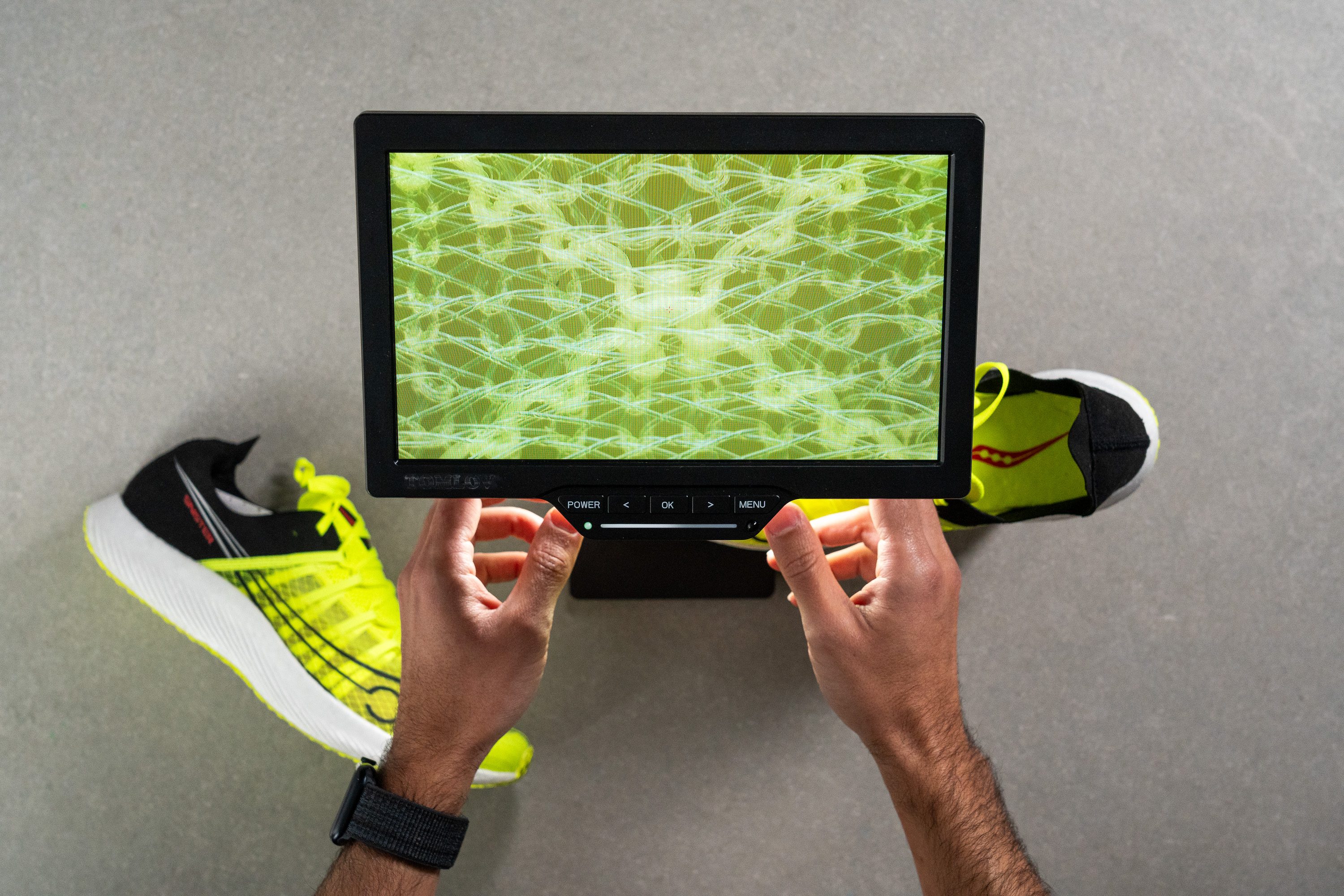
In our experience, the thinner the upper, the more jaw-droppingly impressive it appears under our microscope—and the Sinister definitely confirmed this. Isn't it amazing to see?
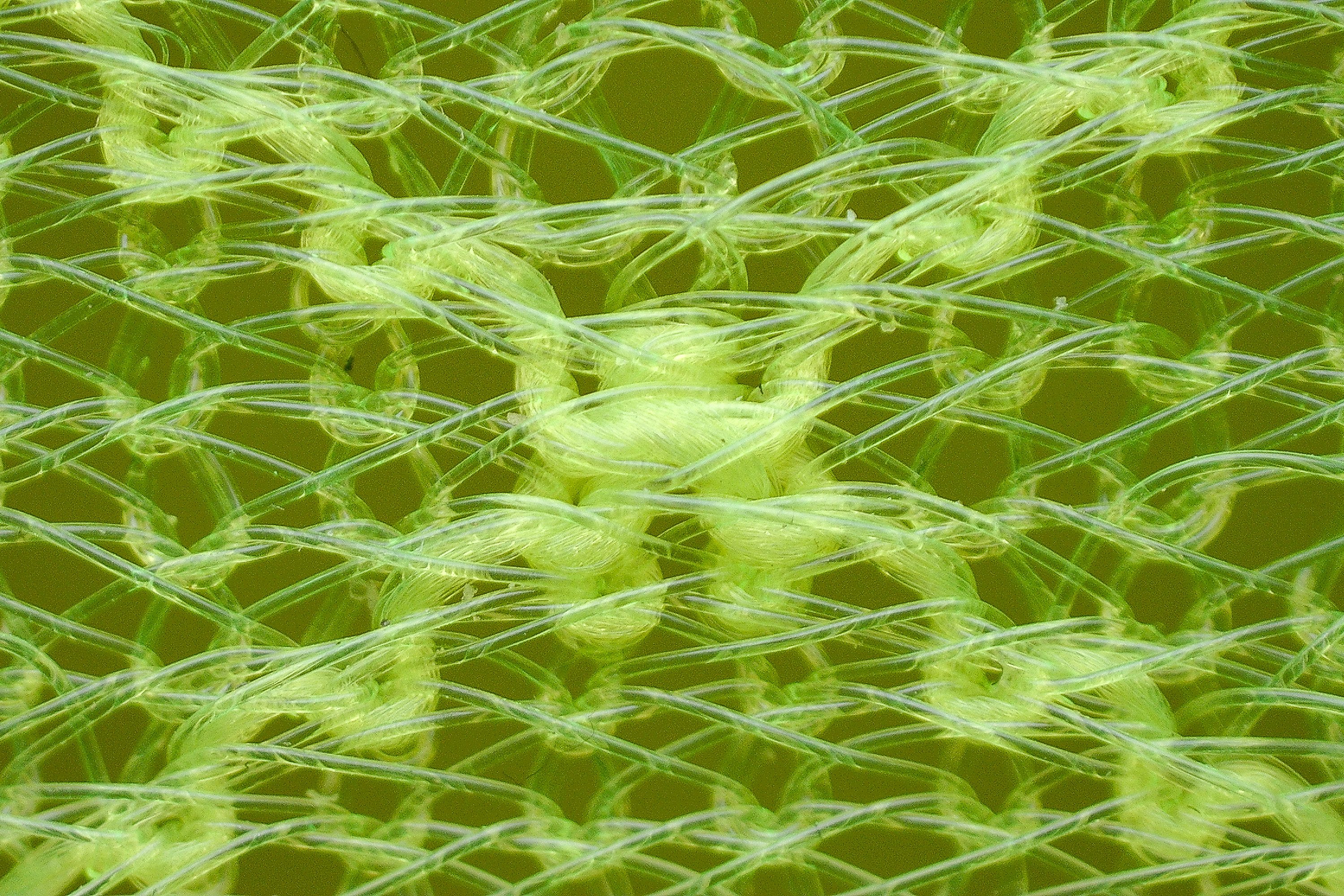
Upon manually inspecting the upper, we confirmed it doesn't feel padded or cosy—in fact, quite the opposite.
But that's precisely the point with a shoe like this. The Sinister is like a go-kart, designed for going fast AF and having fun.
| Sinister | 4 |
| Average | 3.7 |
Stability
Lateral stability test
Those with stability issues might not find the Sinister stable, as the minimal upper doesn't offer much support in that regard and it's a narrow shoe. However, for neutral runners, it feels quite stable due to the grounded feel provided by the low stack height.
The sense of stability in this model comes from its lower profile. Also, we've found that cornering in this shoe is amazing, making it a great choice for 5K/10K races with sharp turns.
Torsional rigidity
We've mentioned before how incredibly flexible this shoe is, geared towards a natural running style—there are no aids like carbon plates, rods, or other stiffening agents inside the midsole.
That's why the Sinister scored a 1 out of 5 in our flexibility test. It truly feels like many barefoot shoes, showcasing just how minimal it is.
| Sinister | 1 |
| Average | 3.5 |
Heel counter stiffness
About the heel counter stiffness... well, there isn't any, so it's another 1 out of 5 for us.
To be fair, we must say that there's a thin piece of cardboard shaping the heel area, but as shown in the video, it doesn't add much stiffness. Plus, there are no other reinforcements like a heel cup or thermoplastics to firm it up.
| Sinister | 1 |
| Average | 2.9 |
Midsole width - forefoot
At the beginning of this lab review, we compared this shoe to a go-kart, and the midsole dimensions really support that theory.
Measuring just 100.5 mm, the forefoot is quite narrow, making it incredibly agile for speed workouts. In fact, the shoe feels very similar to a track spike, even when you're running on roads.
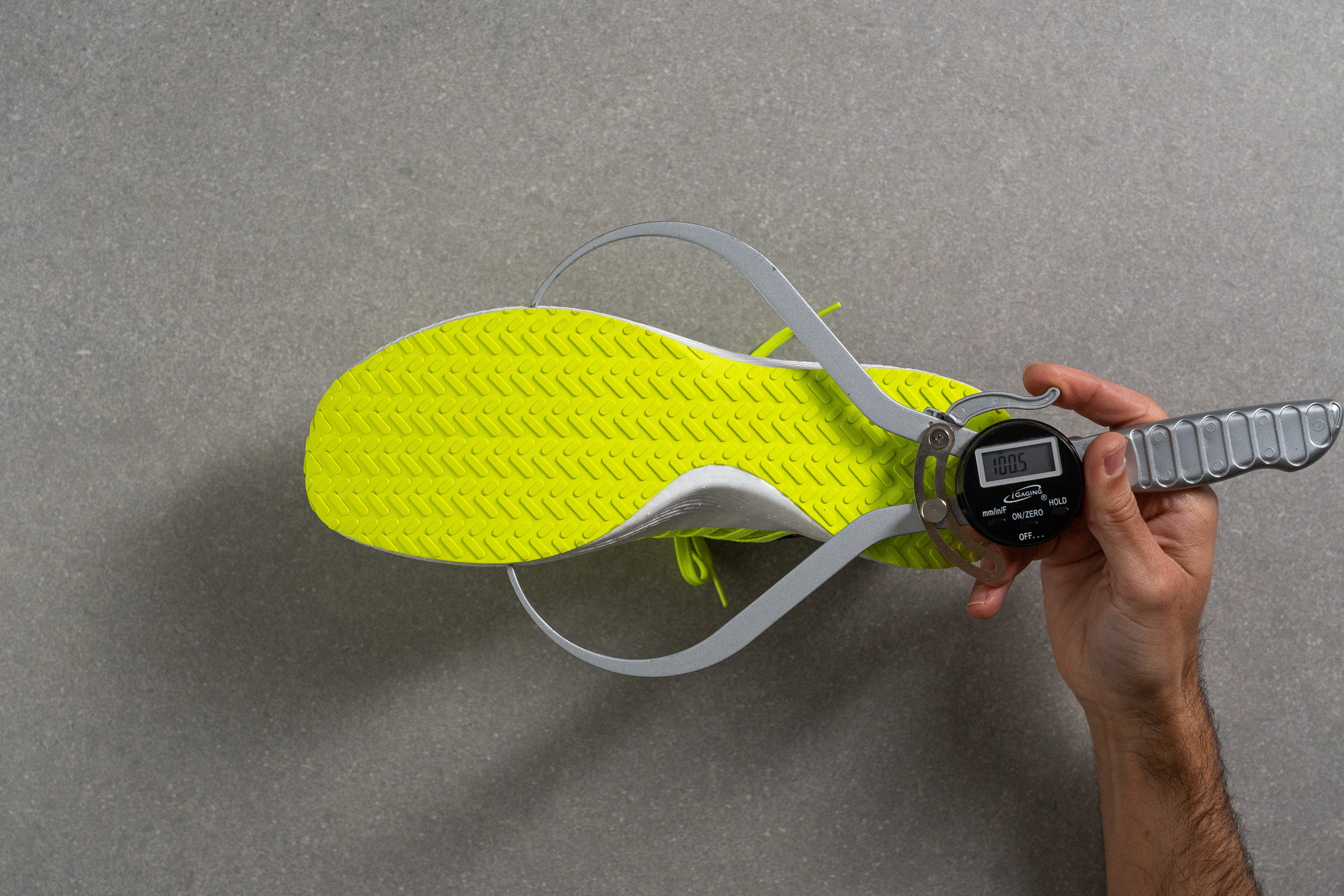
| Sinister | 100.5 mm |
| Average | 114.4 mm |
Midsole width - heel
And what about the heel? At just 76.5 mm, we can only recommend this shoe for those with a neutral, pristine running technique.

| Sinister | 76.5 mm |
| Average | 90.7 mm |
Durability
Toebox durability
With such an incredibly thin upper, we weren't too optimistic about the toebox's durability.
After our Dremel test, we discovered a large hole in the upper that means a 1/5 score. But this is completely normal—what else could we expect from such a minimal mesh?

| Sinister | 1 |
| Average | 2.6 |
Heel padding durability
On the contrary, The heel boasts a solid fabric that not only enhances lockdown by preventing heel slippage but also boosts durability with its rugged nature.
After subjecting this area to the same test, we were thrilled to find a 4 out of 5 result, which is absolutely awesome.

| Sinister | 4 |
| Average | 3.4 |
Outsole hardness
Then, we turned our attention to the outsole, which, unsurprisingly, also looks really thin.
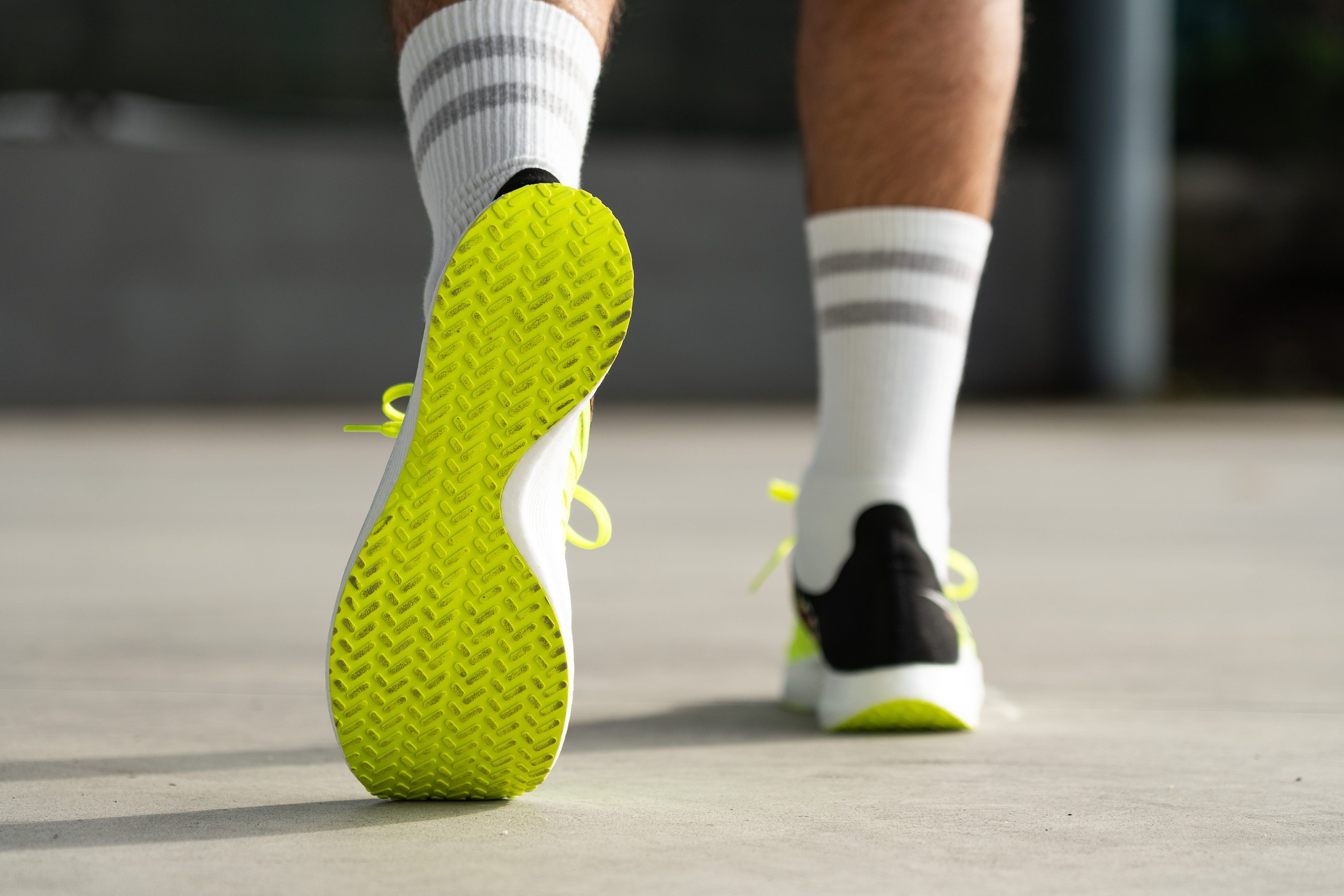
In our first test, we measured its hardness. It registered at 81.4 HC on our Shore C durometer, an average result.
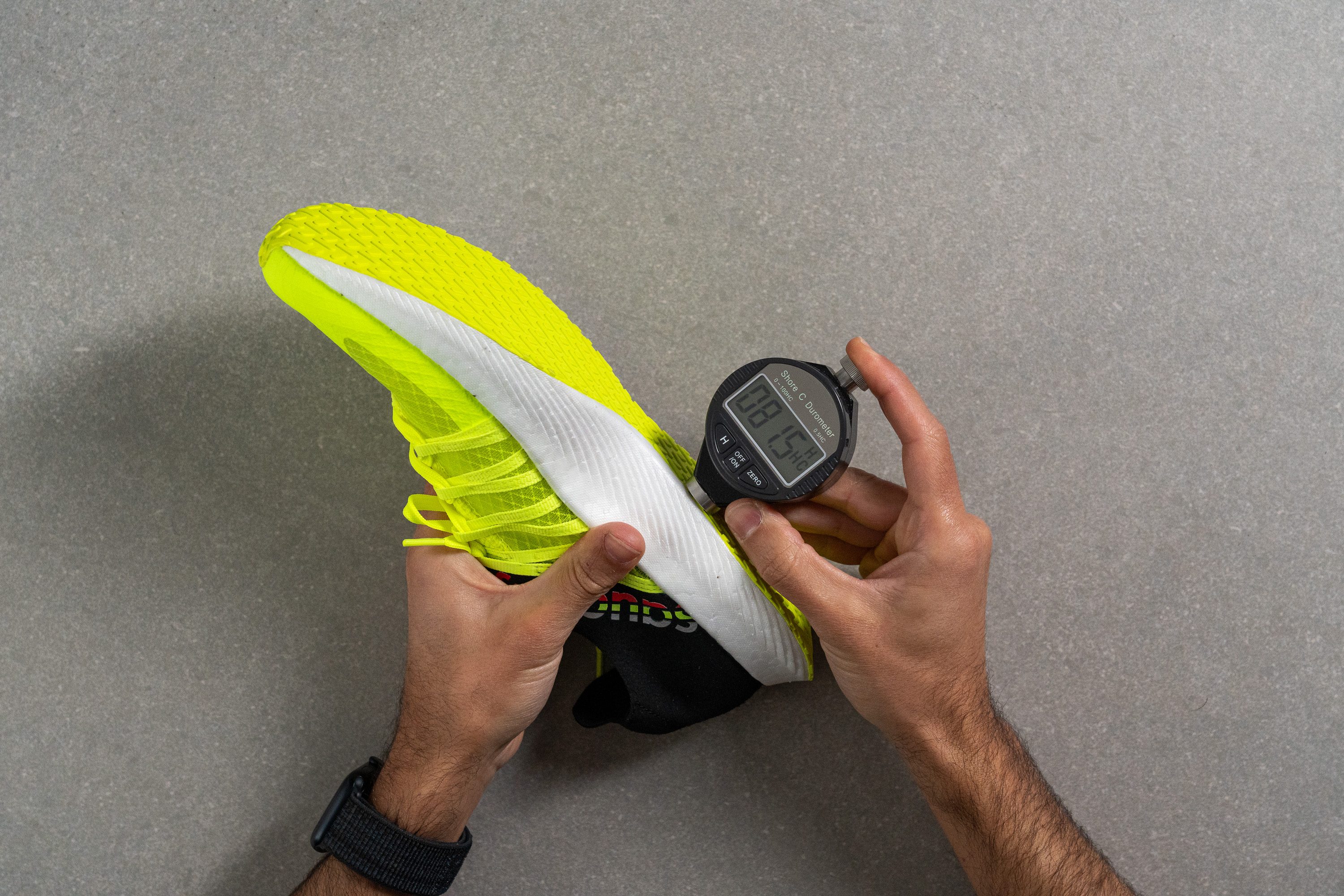
| Sinister | 81.4 HC |
| Average | 79.2 HC |
Outsole durability
After the hardness test, we proceeded to a more intense trial with our final Dremel appearance. In this phase, we applied the Dremel more vigorously and for a longer duration to test the tougher material.
The outcome was a 1.3 mm indentation, a bit more disappointing than most shoes. This suggests that the shoe might wear out quicker than other options.
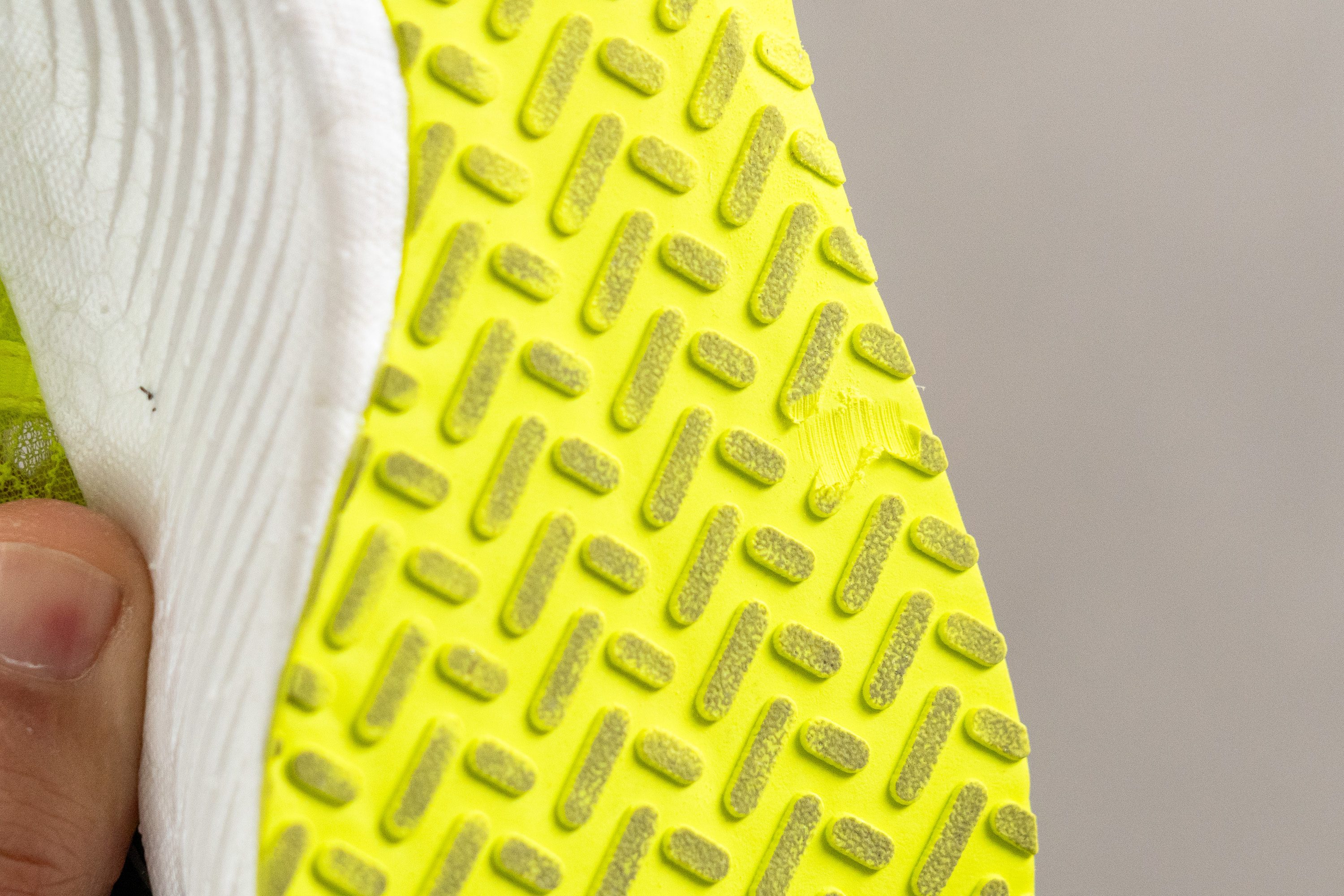
| Sinister | 1.3 mm |
| Average | 1.1 mm |
Outsole thickness
Since weight is a major selling point of this ultra-light shoe, Saucony opted for just 2.5 mm of thickness. However, this thinness could result in faster wear and tear, compounding the durability concerns we previously mentioned.
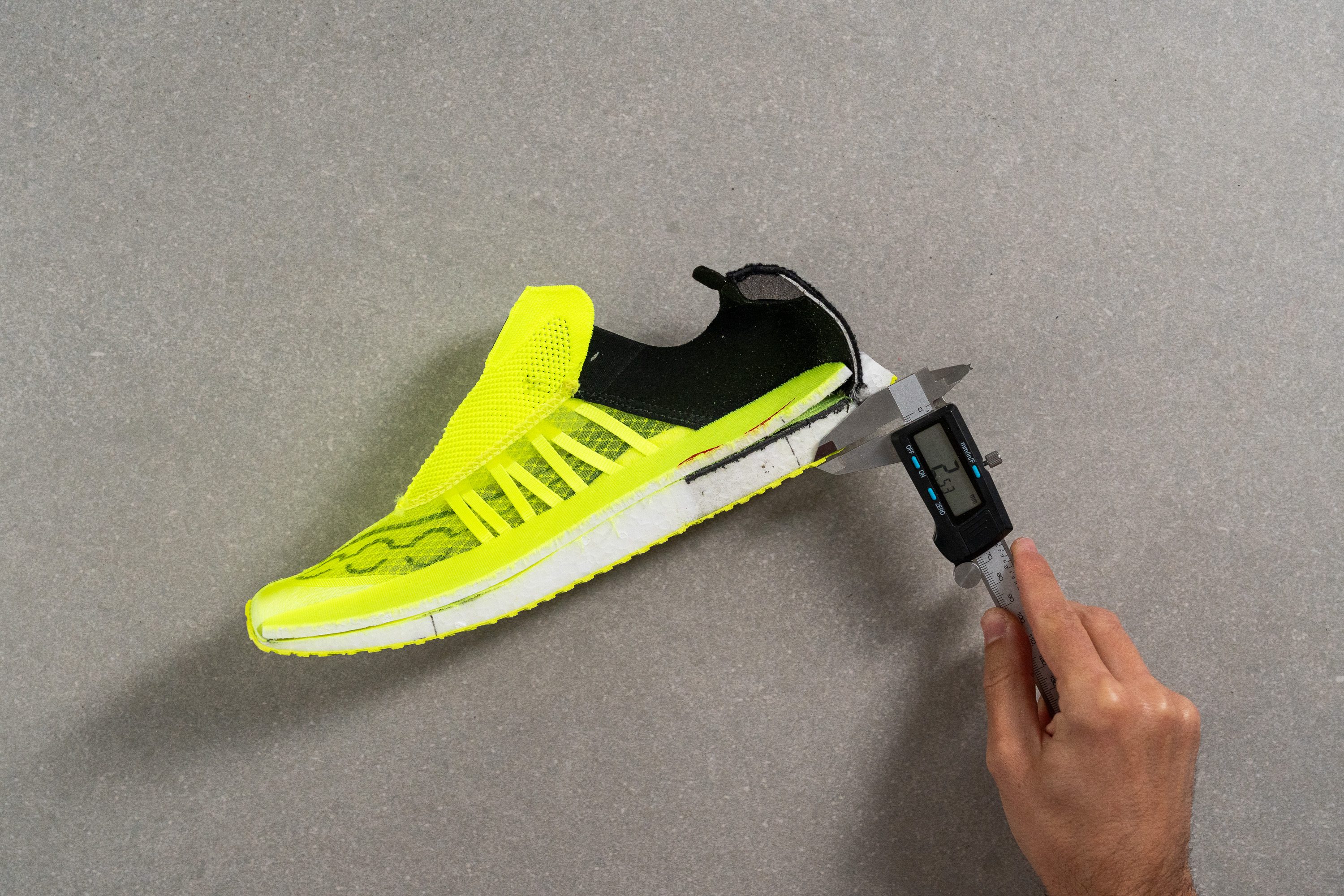
| Sinister | 2.5 mm |
| Average | 3.2 mm |
Misc
Insole thickness
The insole is generously padded at 5.3 mm, offering another potential area to reduce weight in a second version, if Saucony decides to release one. However, given the current market trends, it's uncertain if this will happen.
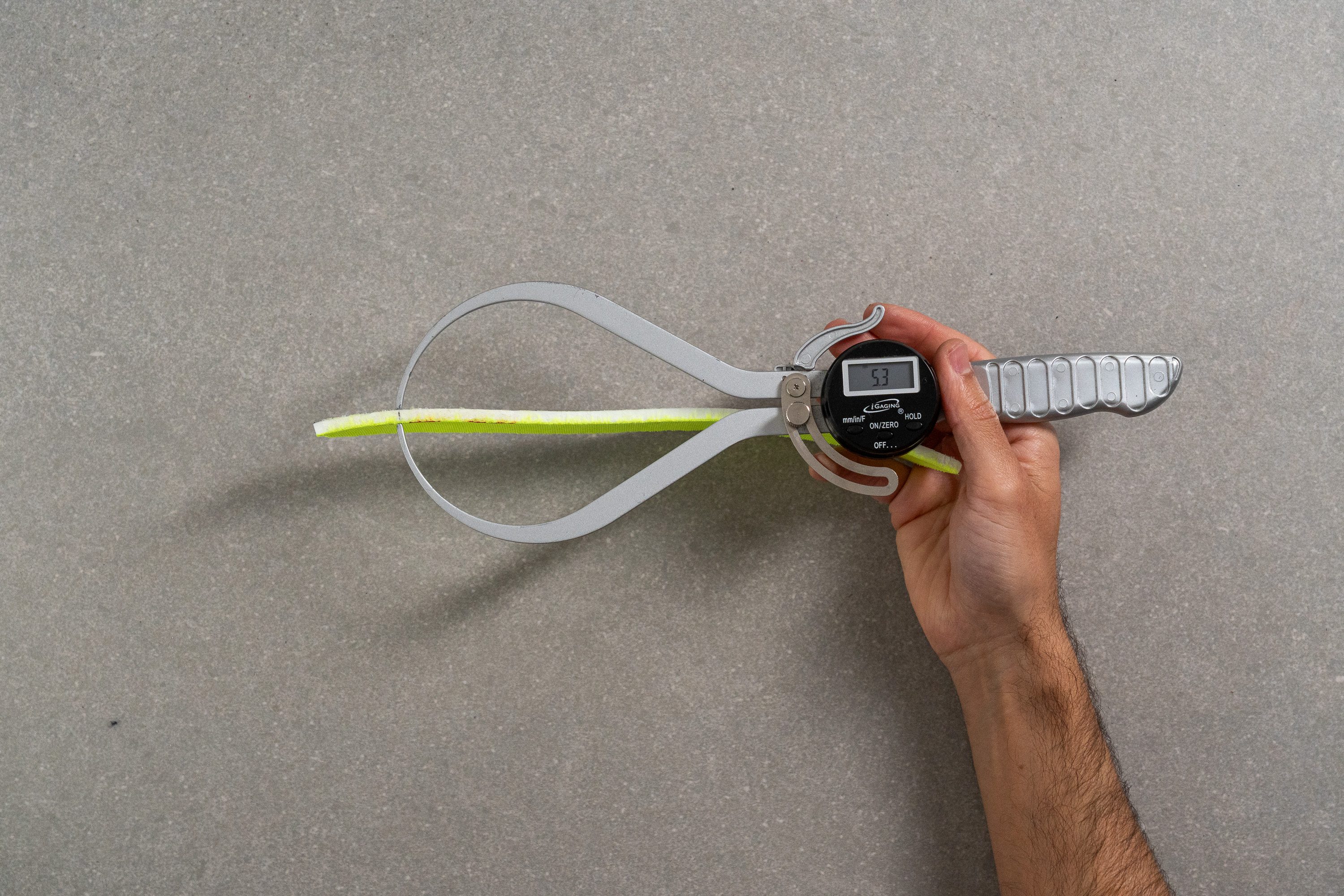
| Sinister | 5.3 mm |
| Average | 4.5 mm |
Removable insole
The insole is removable, so you can make the shoe even lighter by running without it or using a thinner option. However, we don't recommend this, as the Sinister already has minimal cushioning...
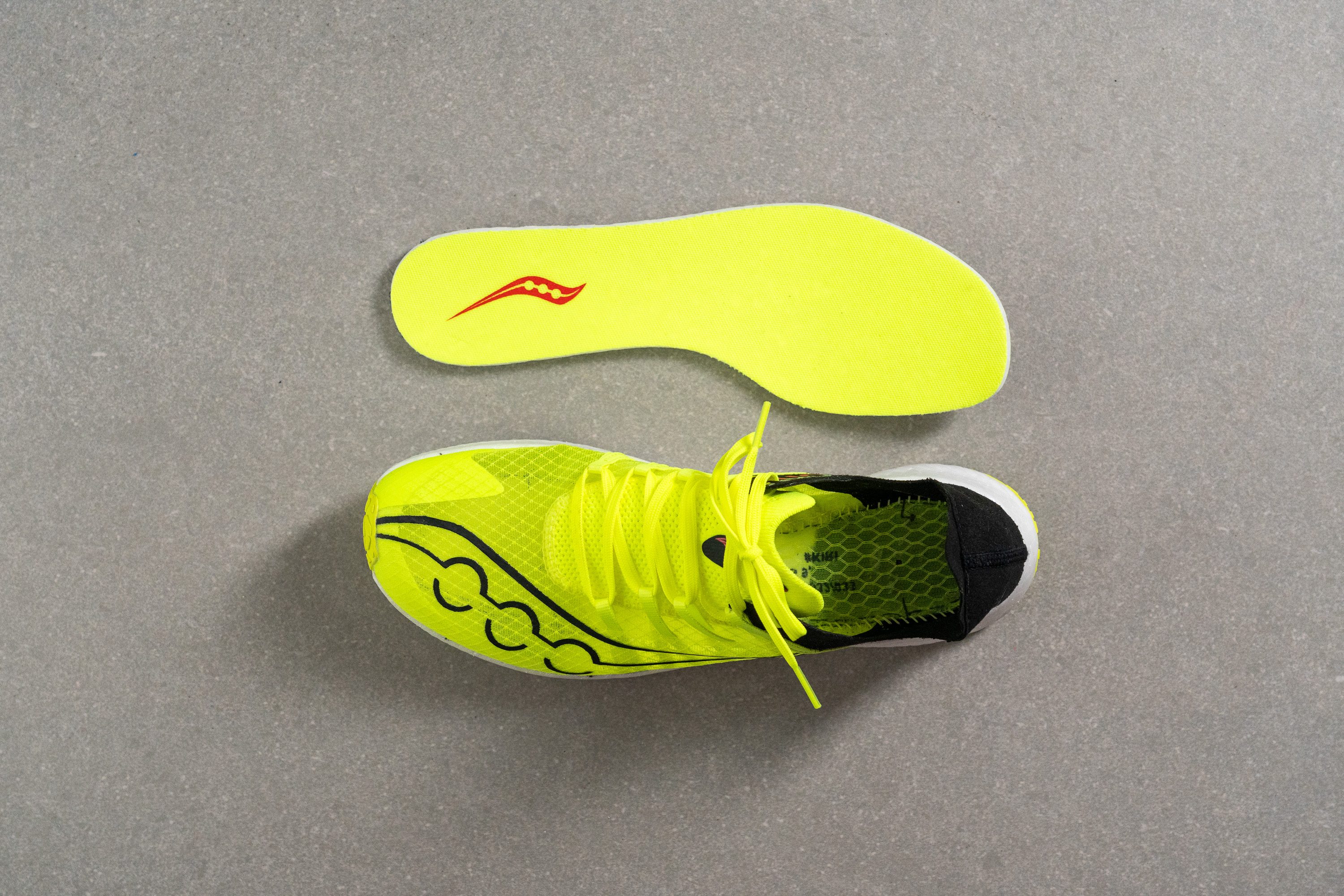
| Sinister | Yes |
Midsole softness in cold (%)
One of the key advantages of using a foam made from Pebax is its extraordinary performance under cold temperatures. As we explained in our guide in this topic, this material excels in chilly conditions. In fact, it only becomes 3.1% firmer in our 20-minute freezer test.
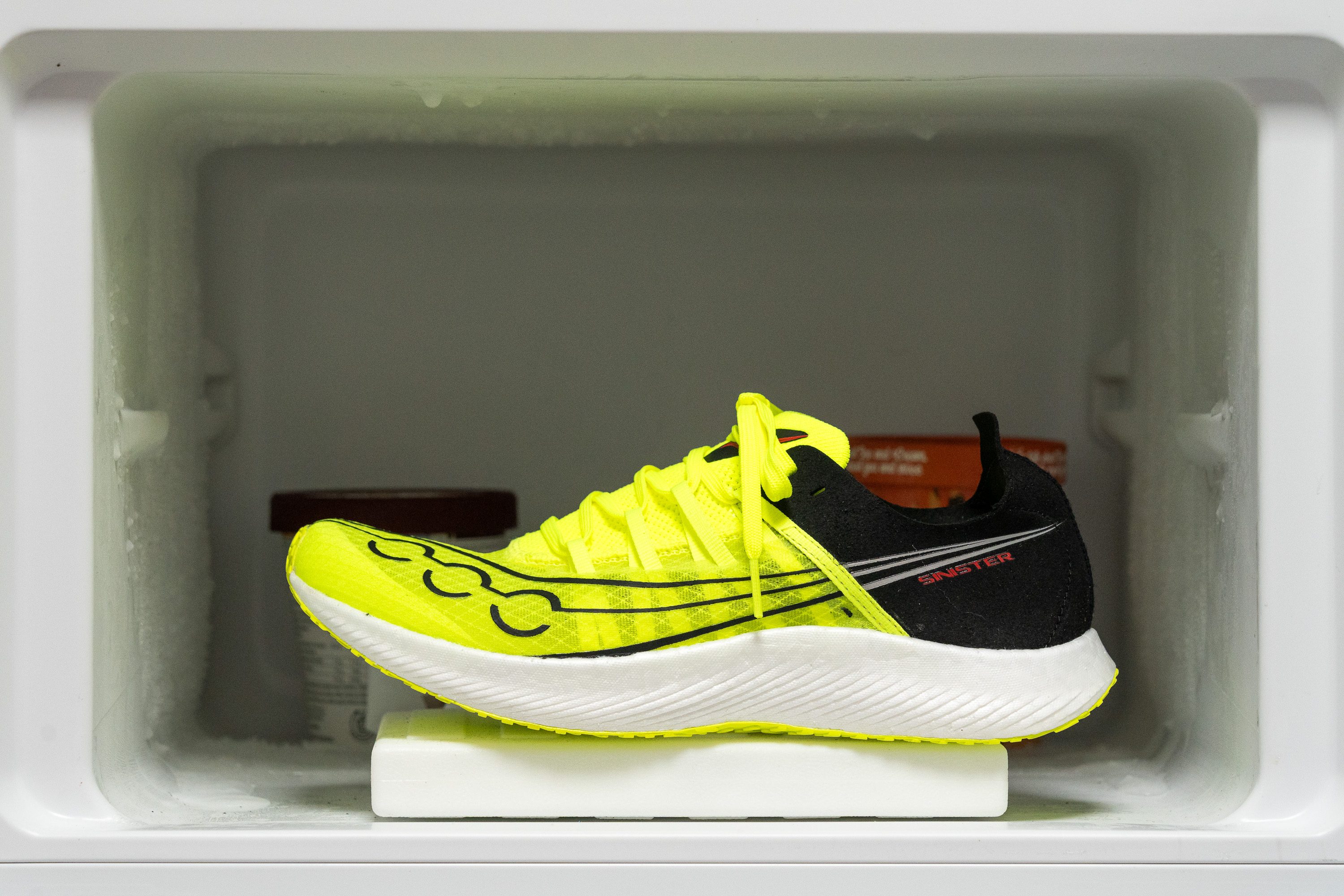
| Sinister | 3% |
| Average | 24% |
Reflective elements
The Sinister lacks any reflective elements, though we weren't really expecting them anyway.
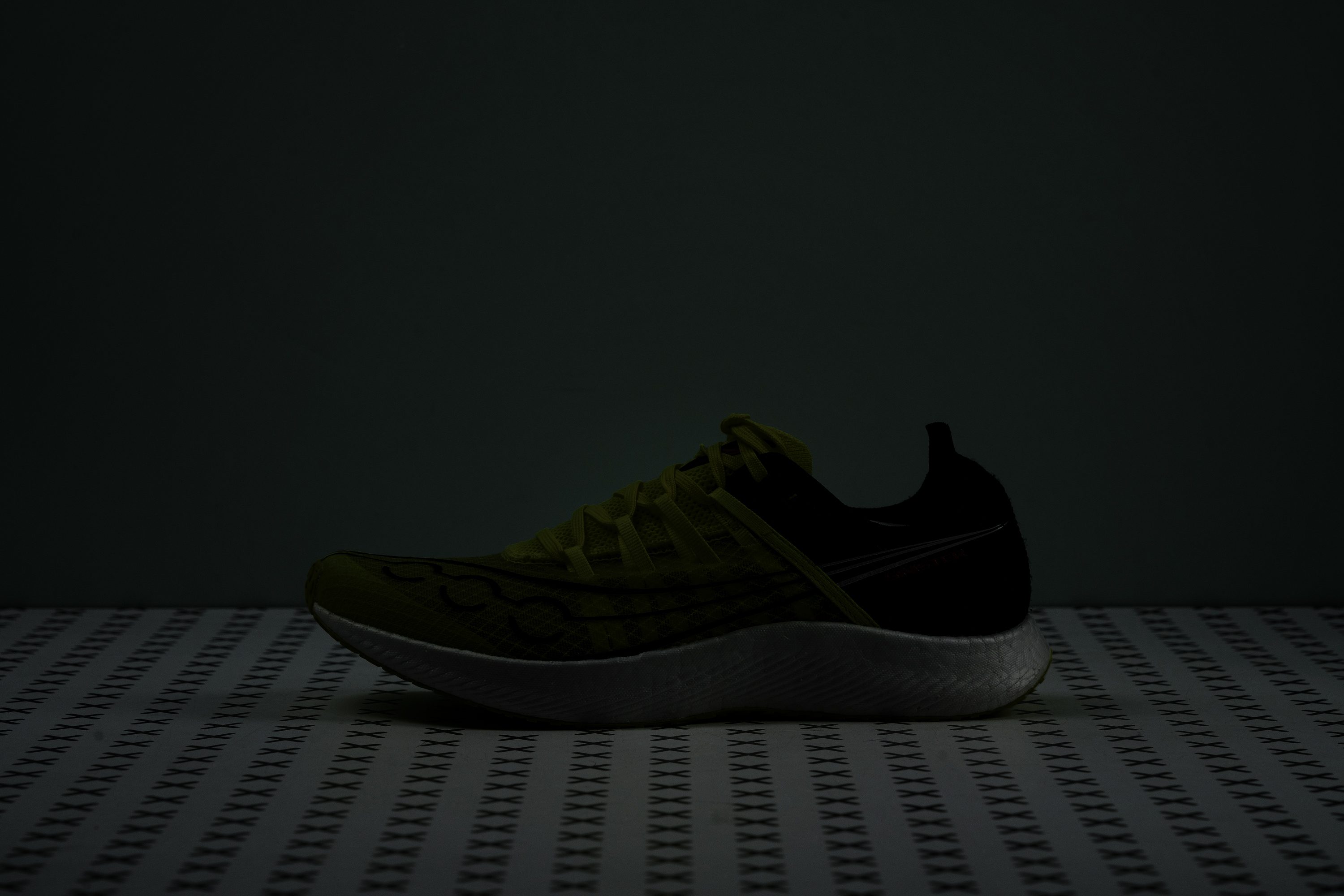
| Sinister | No |
Tongue padding
The tongue, with just 2.1 mm of padding, is surprisingly cushioned in our opinion. Why? Because most modern racing shoes, like the ASICS Metaspeed Sky+, come with padding below 1 mm.
So, the tongue is another area where the Sinister 2 could potentially shed more weight!
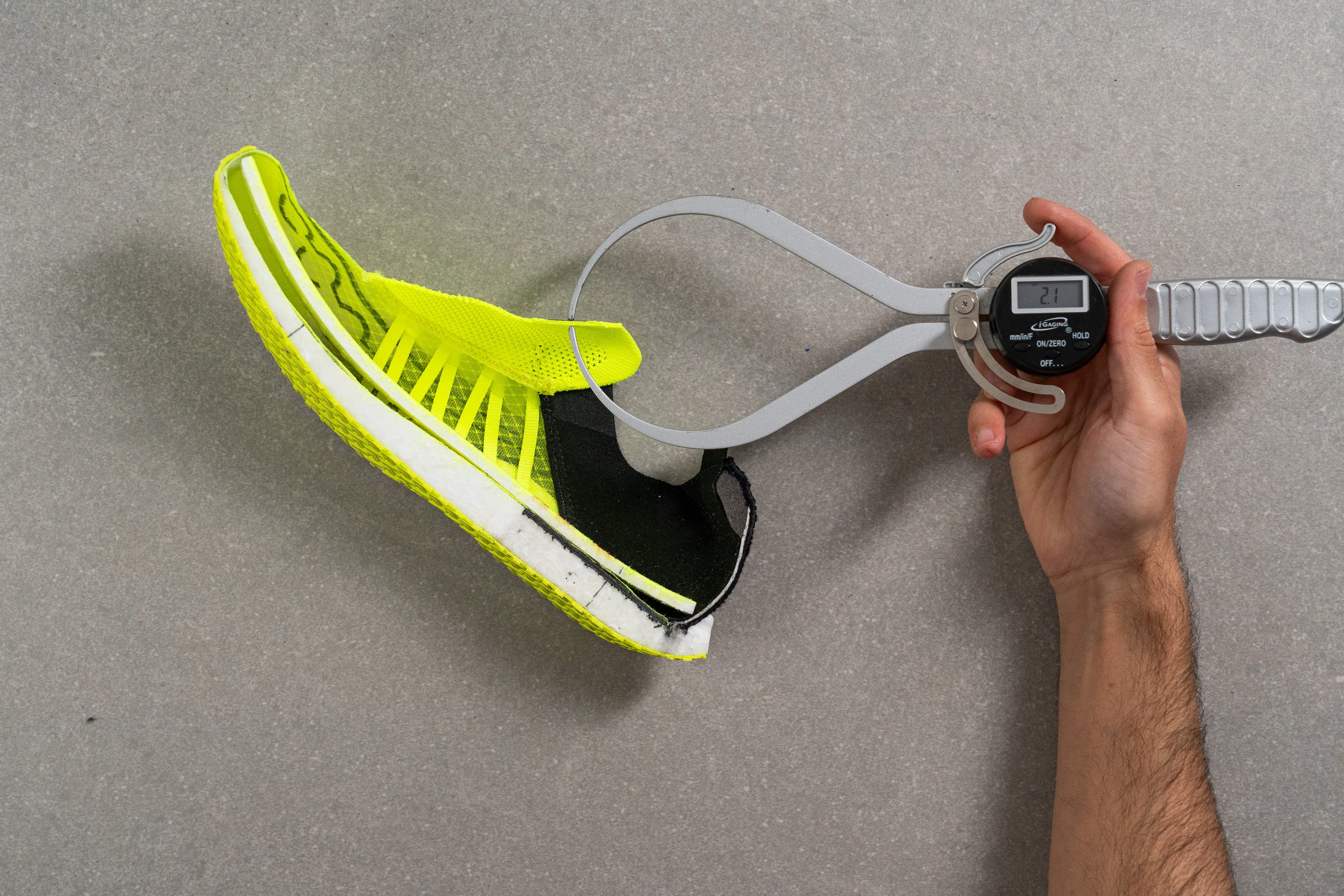
| Sinister | 2.1 mm |
| Average | 5.8 mm |
Tongue: gusset type
The tongue, crafted from stretch knit and seamlessly integrated into the upper in a sock-like design, is something some runners adore and others might not favour as much.
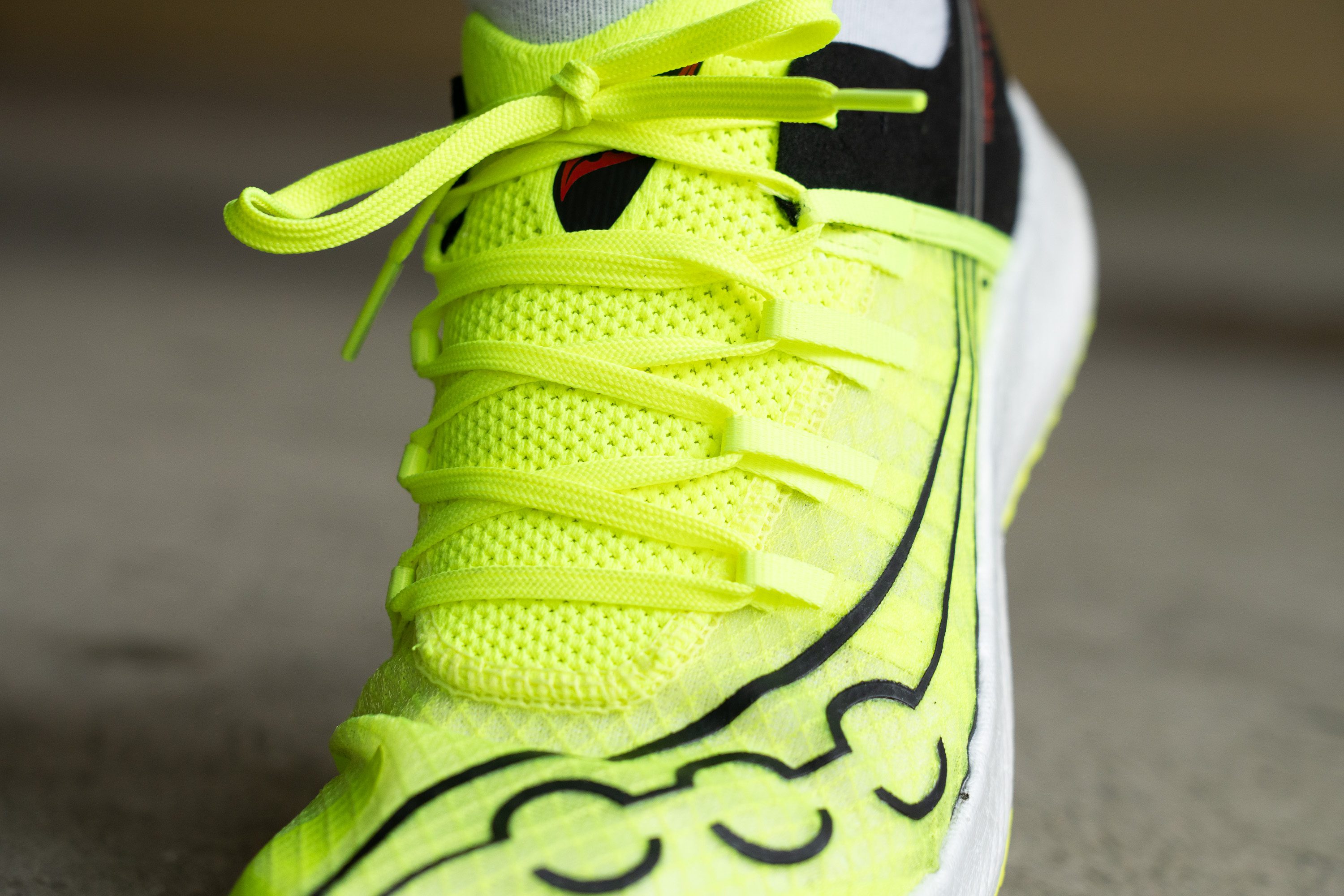
From our experience, this construction ensures a solid lockdown and effectively prevents lace bite, enhancing the overall comfort.
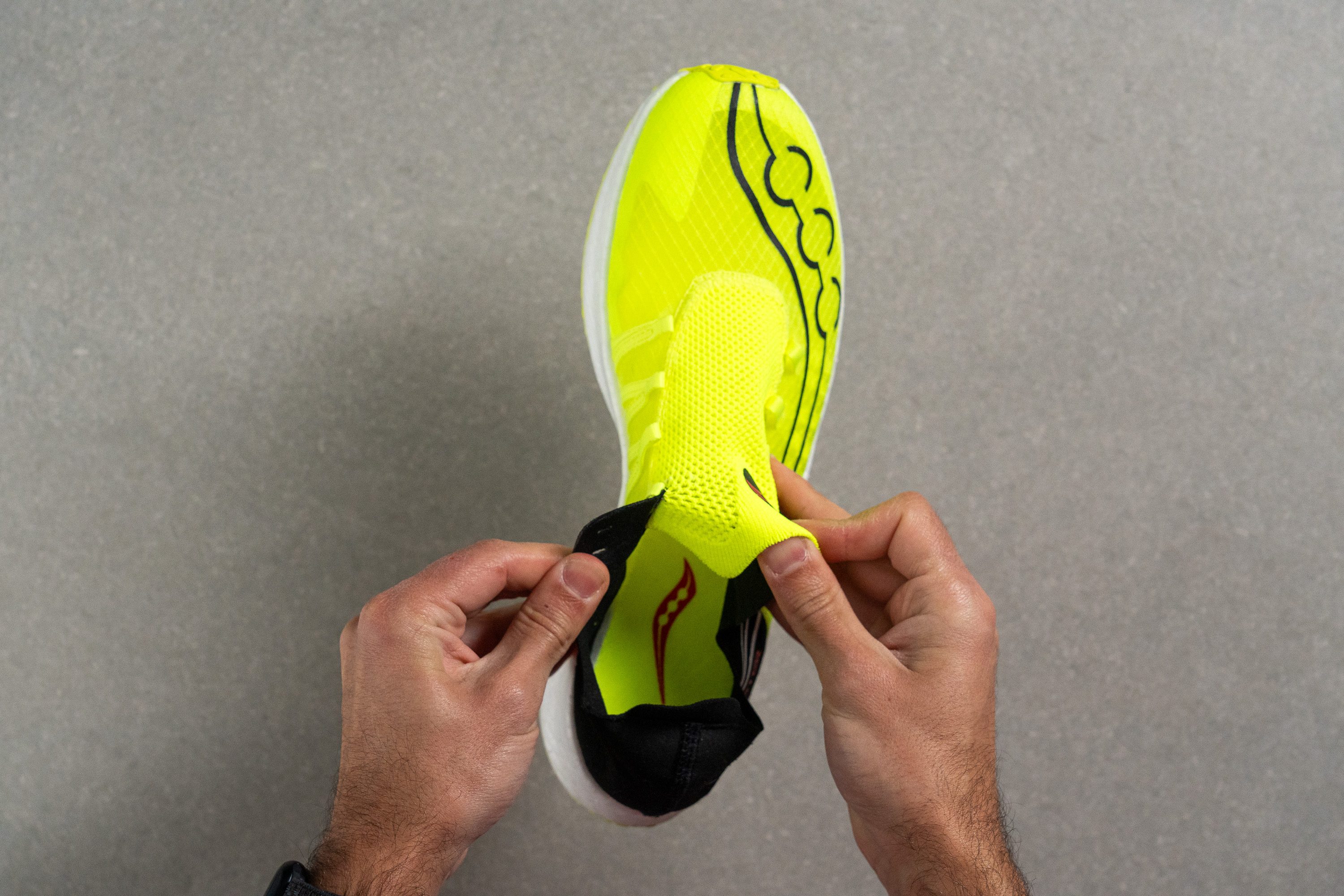
| Sinister | Sock like |
Heel tab
In the heel area, there's no tab, which makes sense given the shoe's low weight is a selling point. However, we think that having a finger-loop heel tab would've made it easier to slip the feet into the shoe.
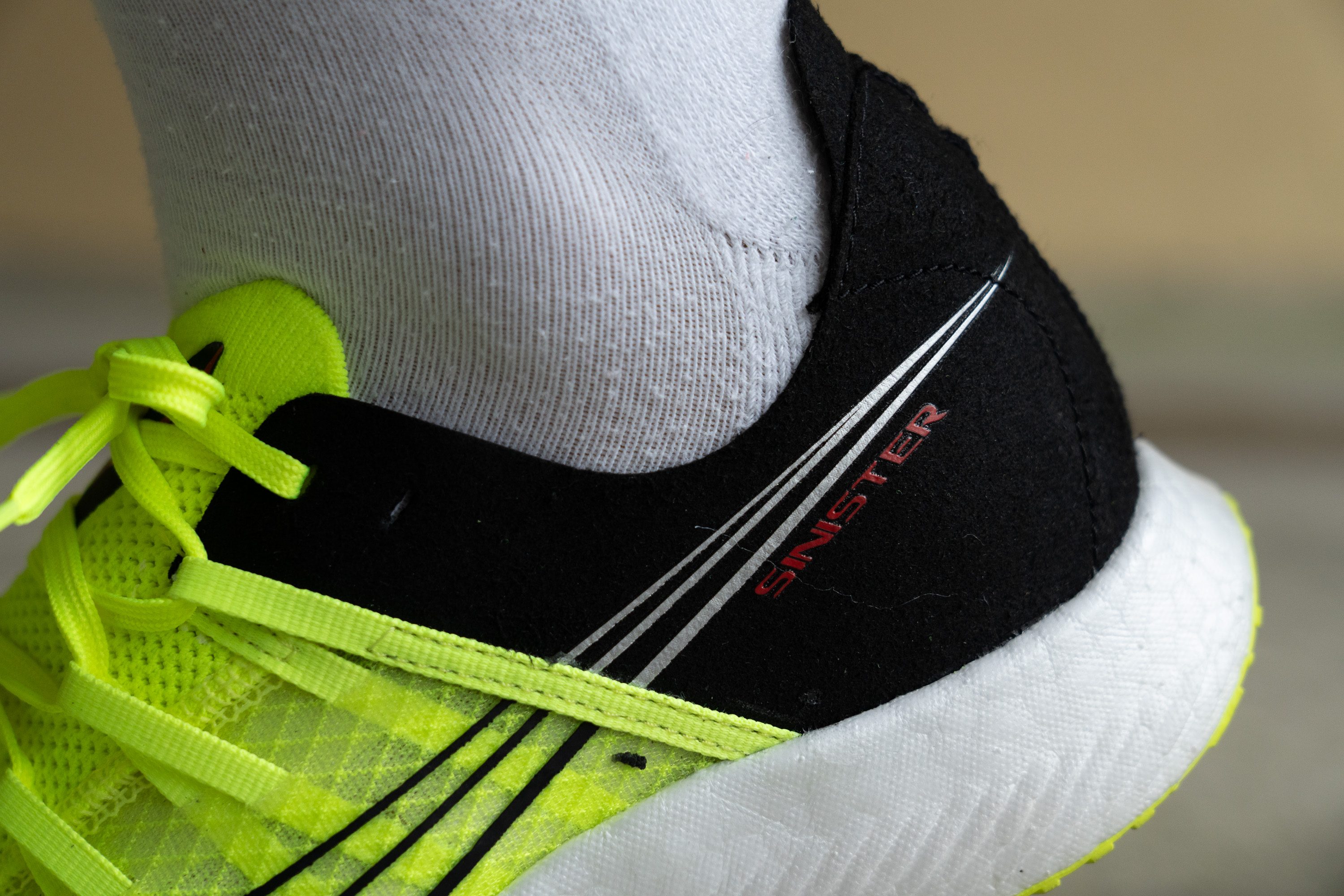
| Sinister | None |

